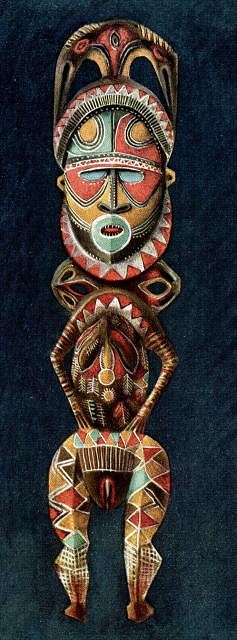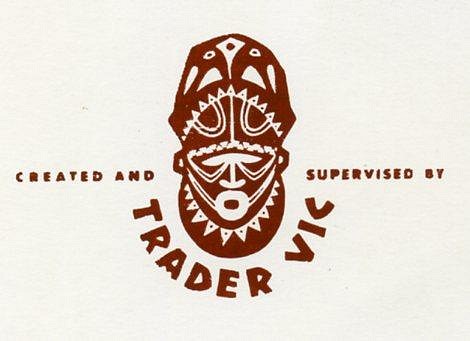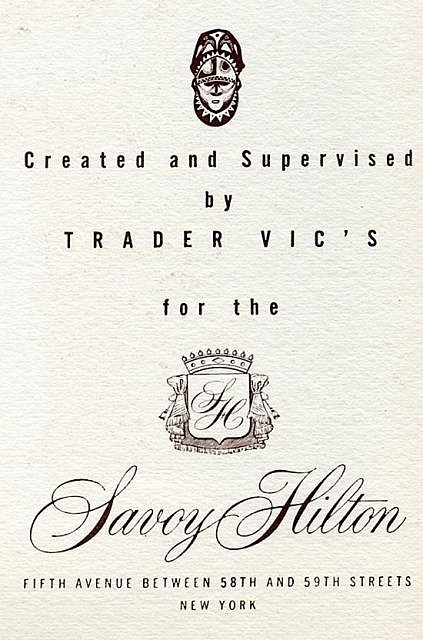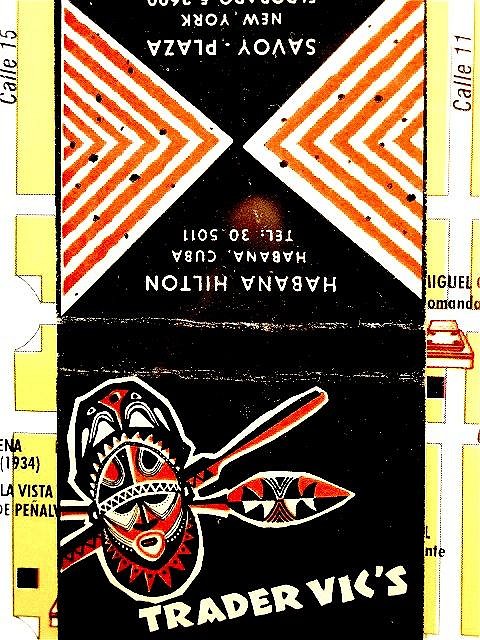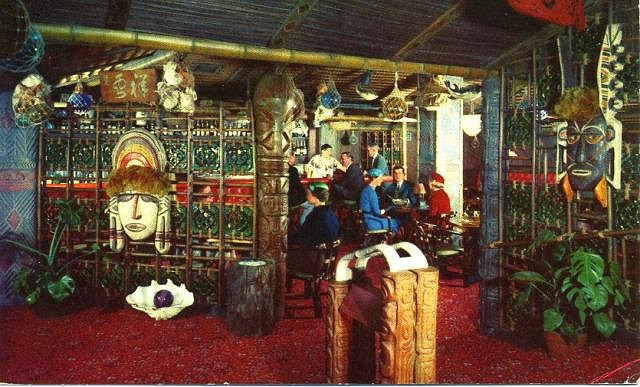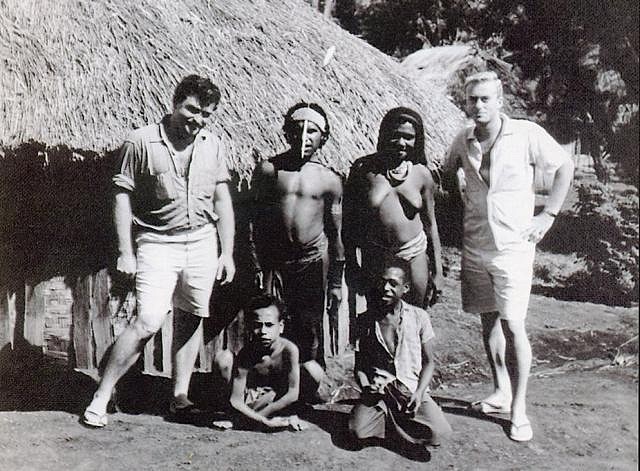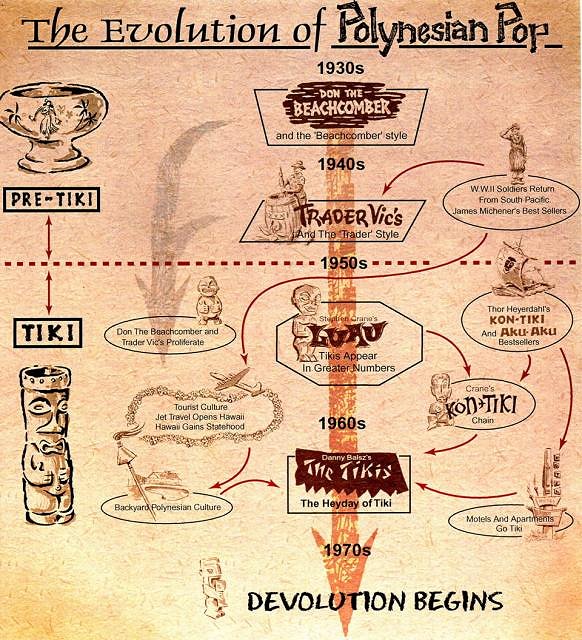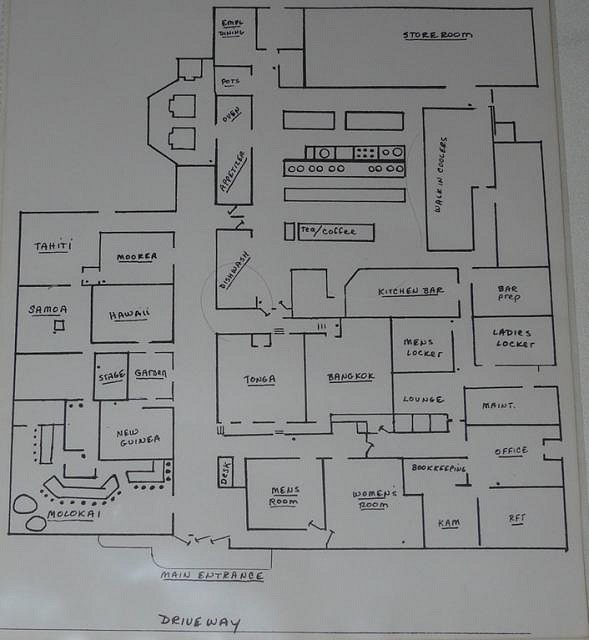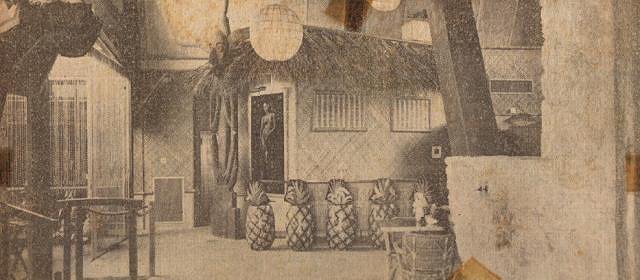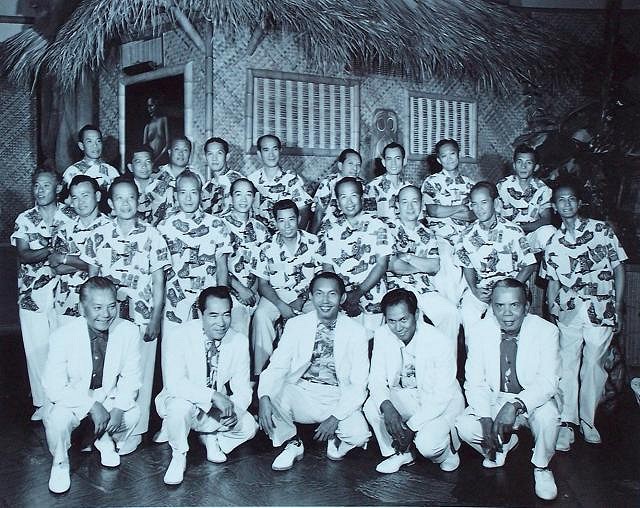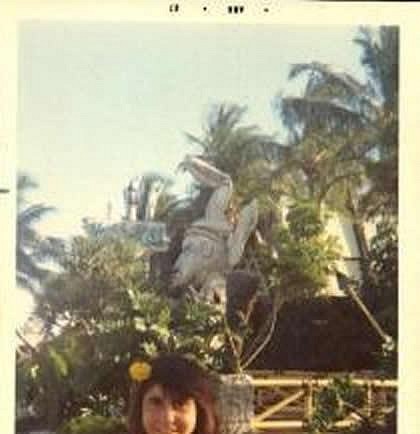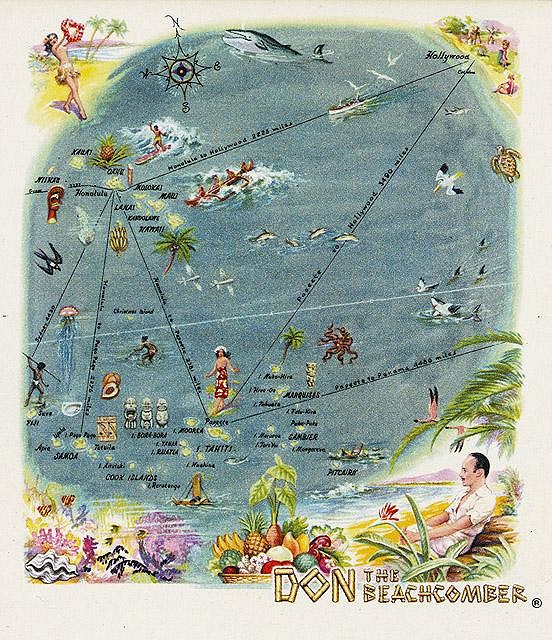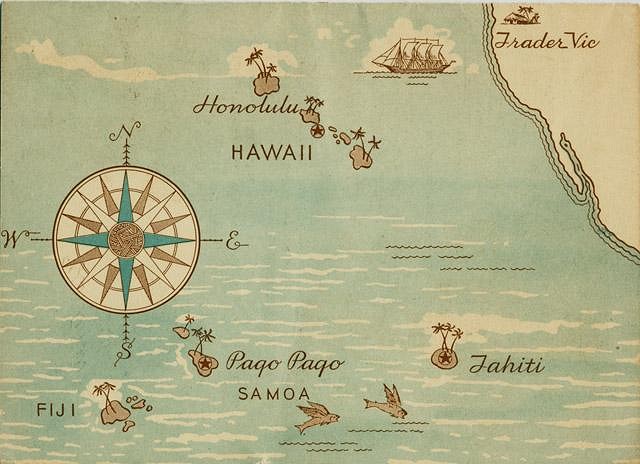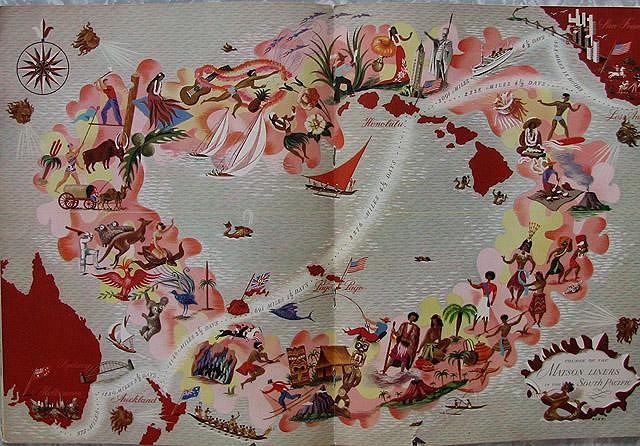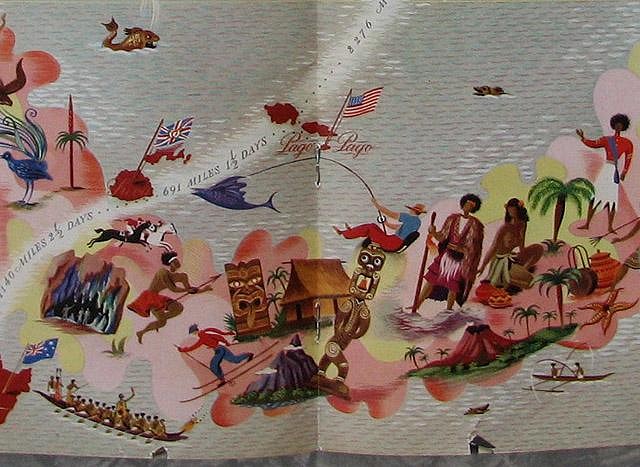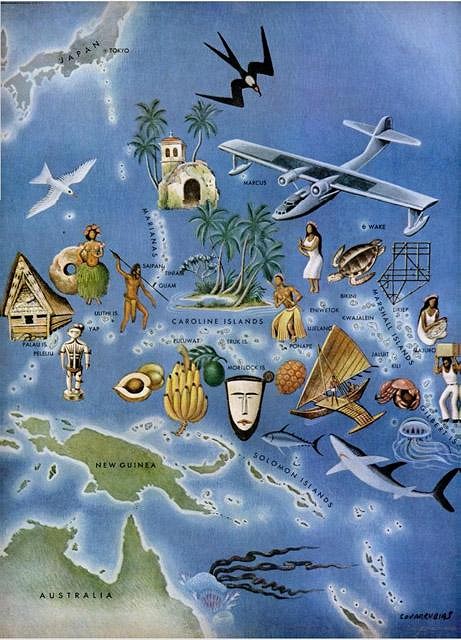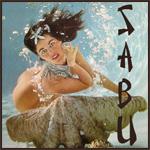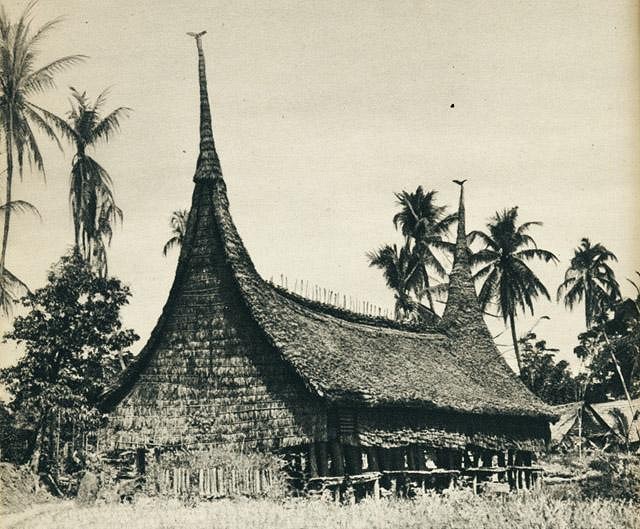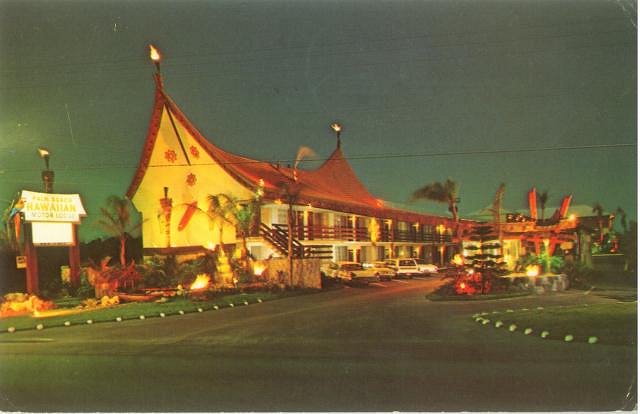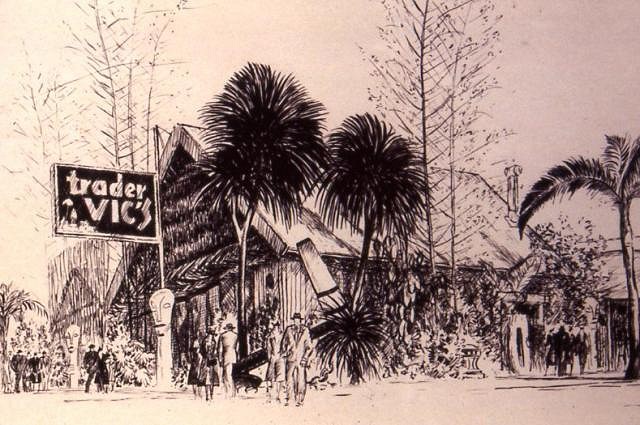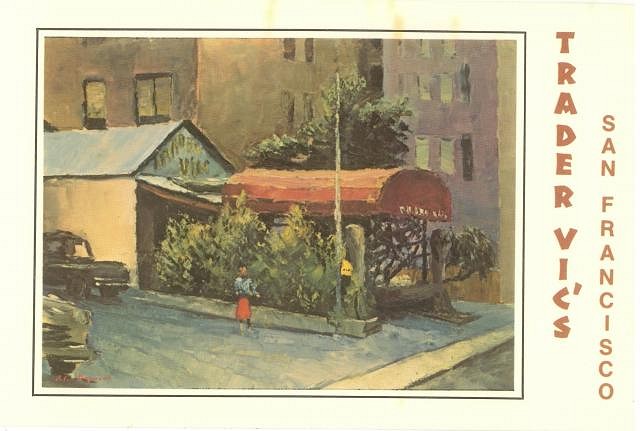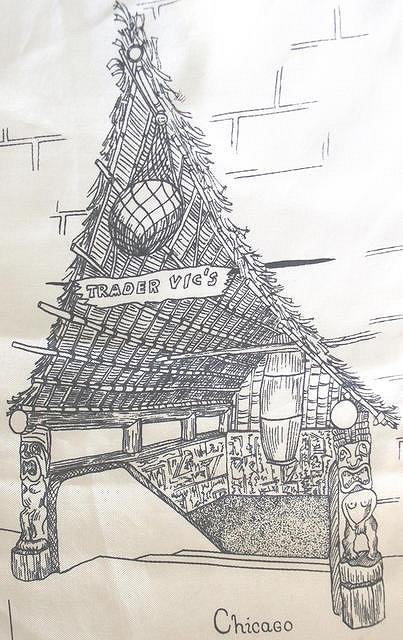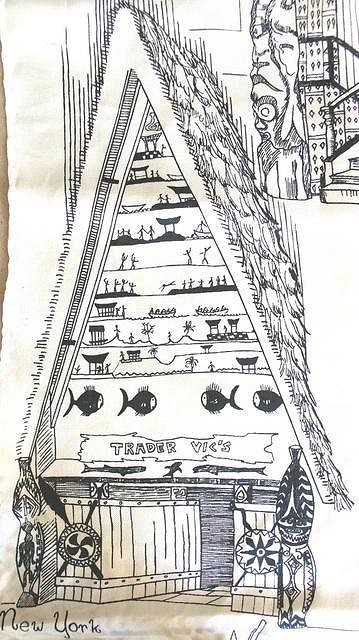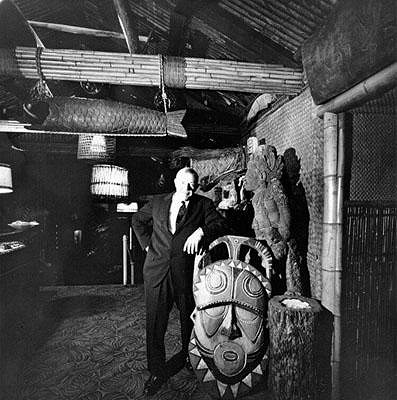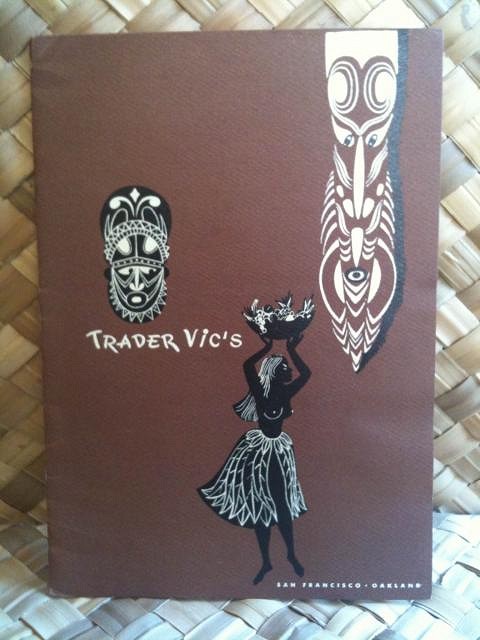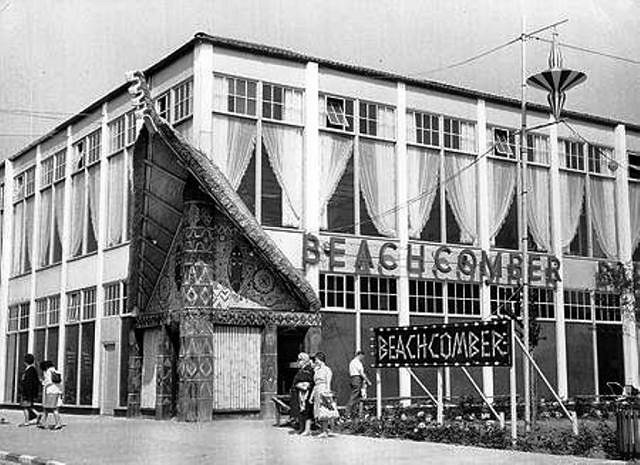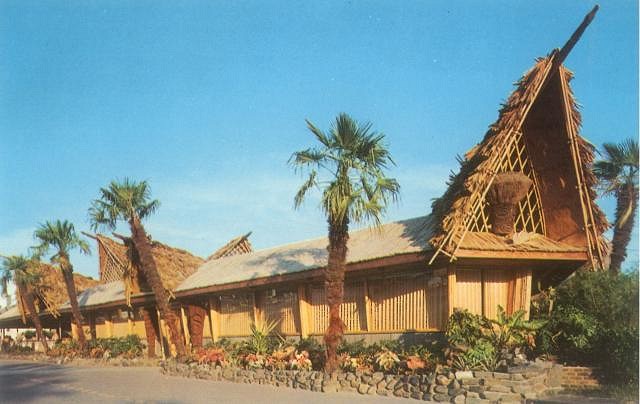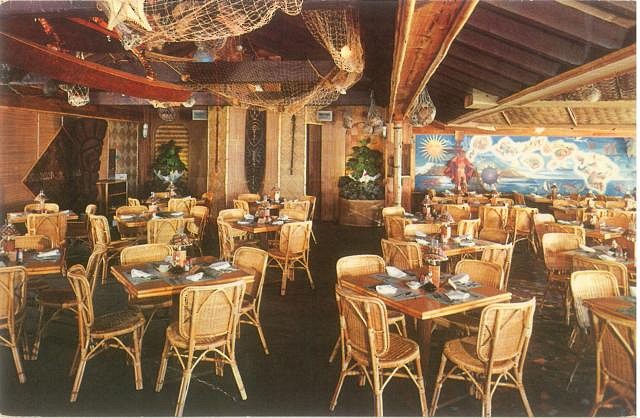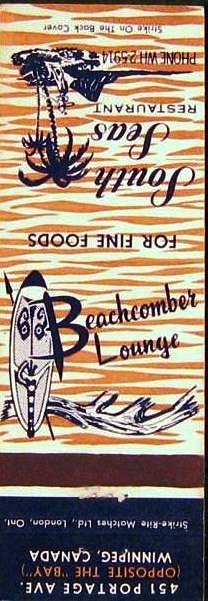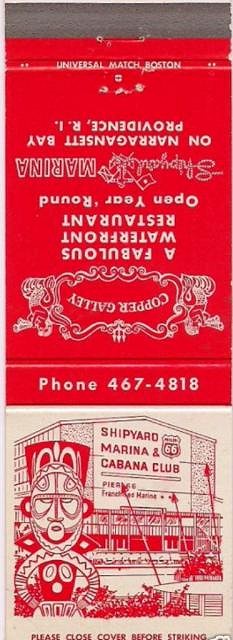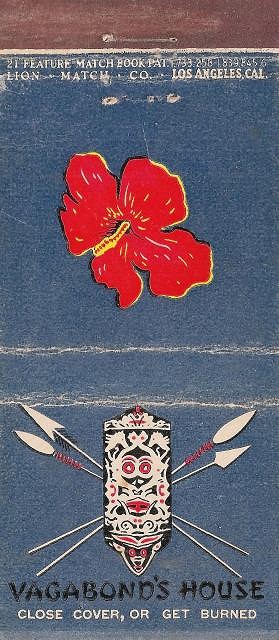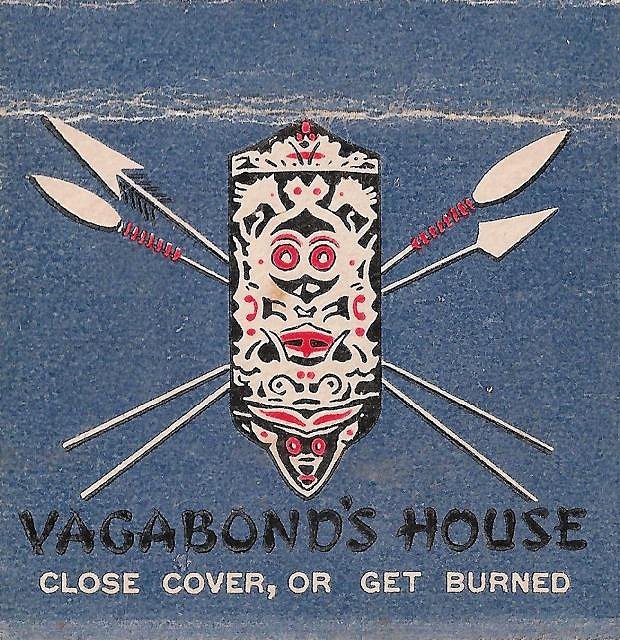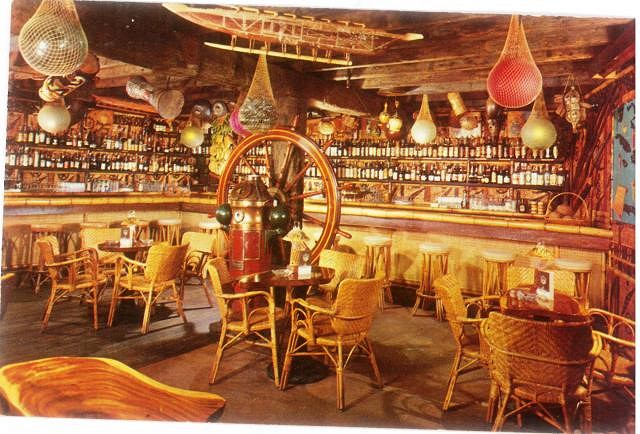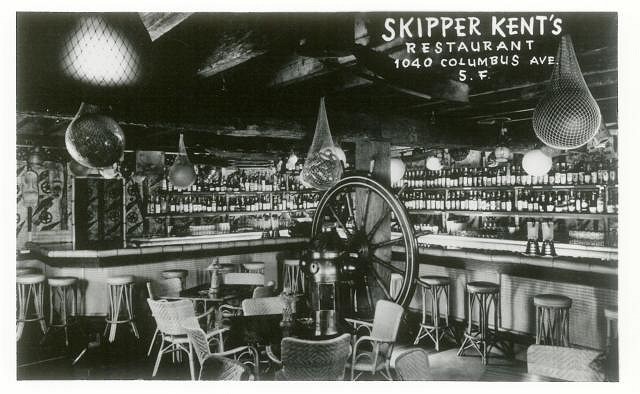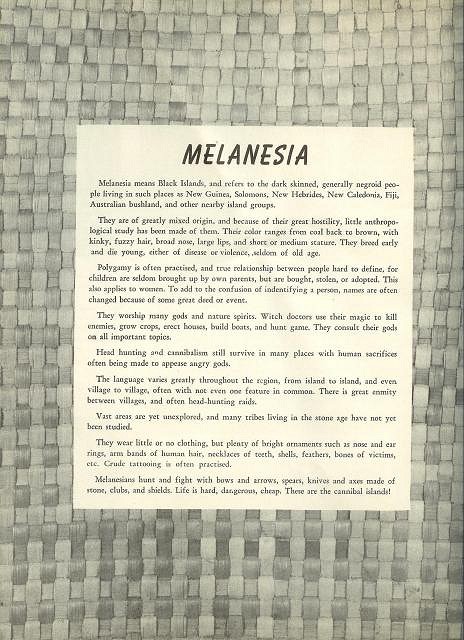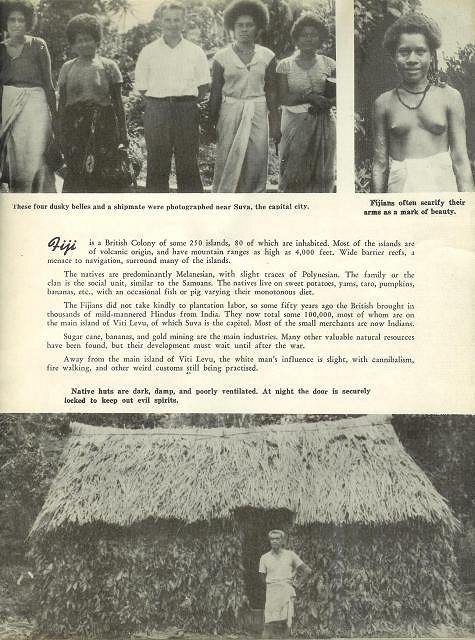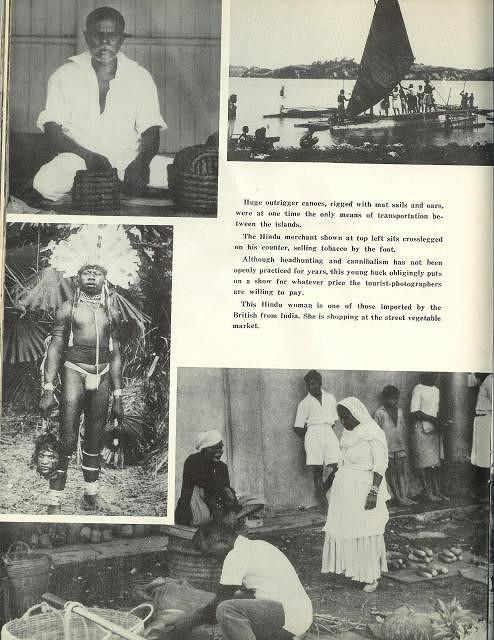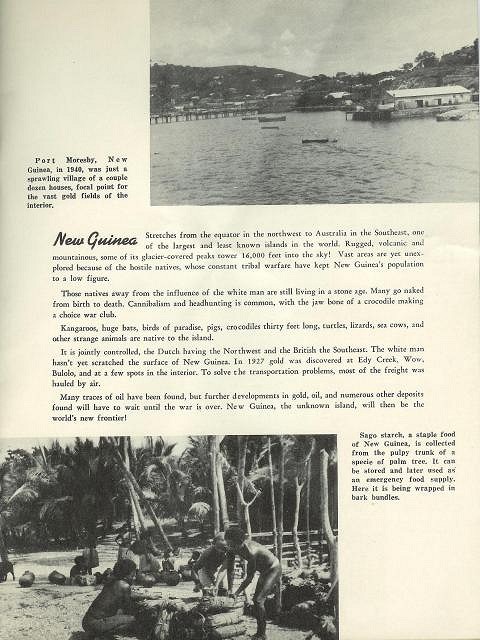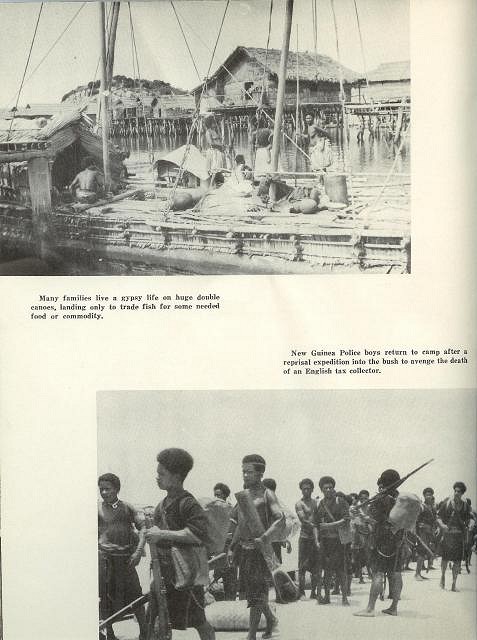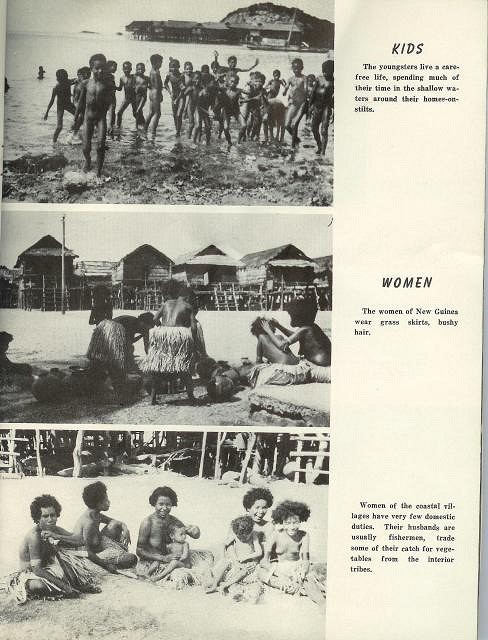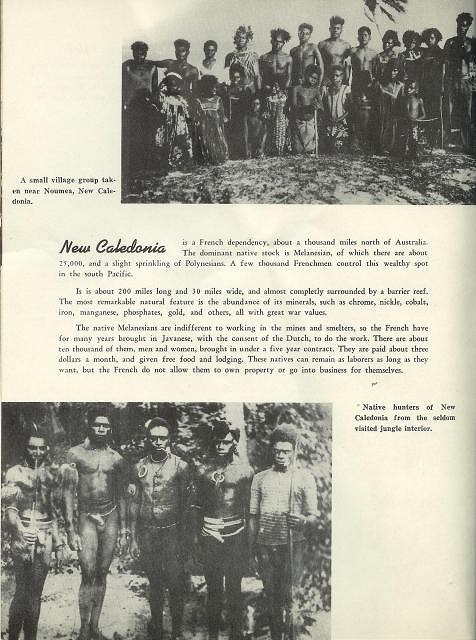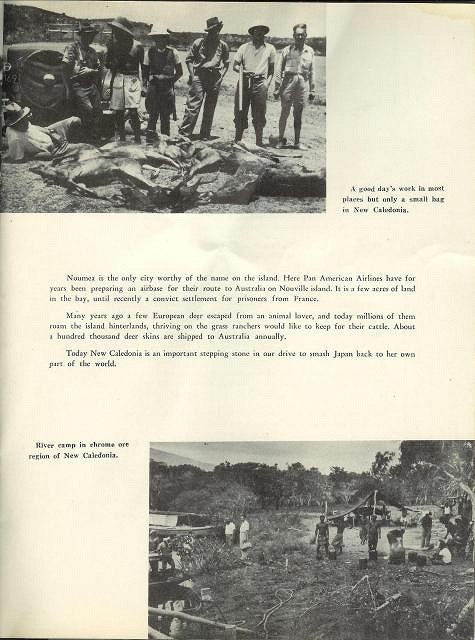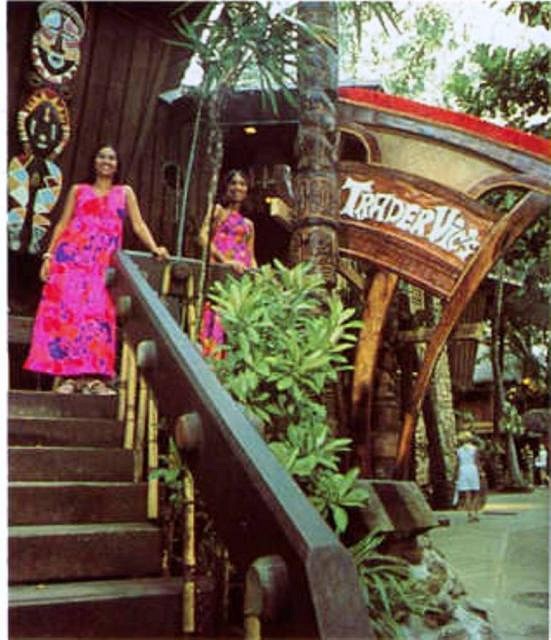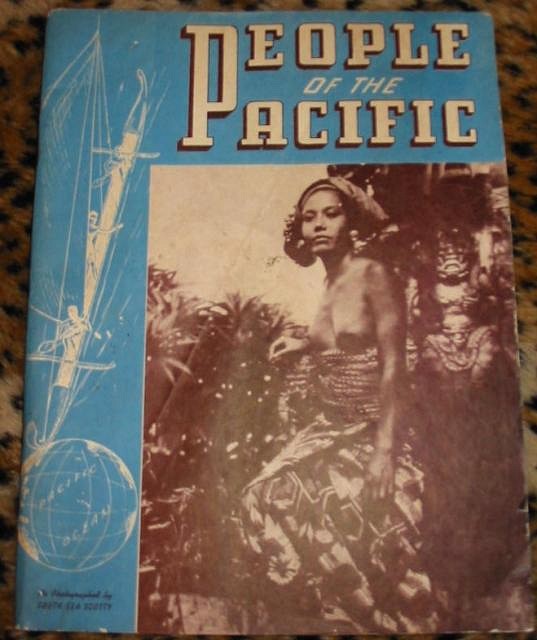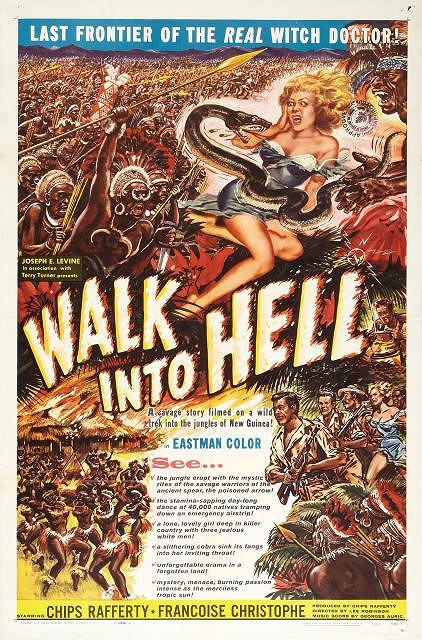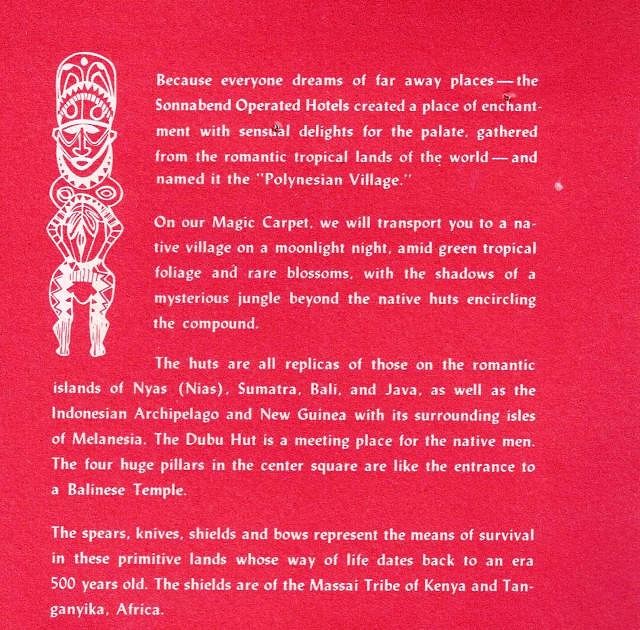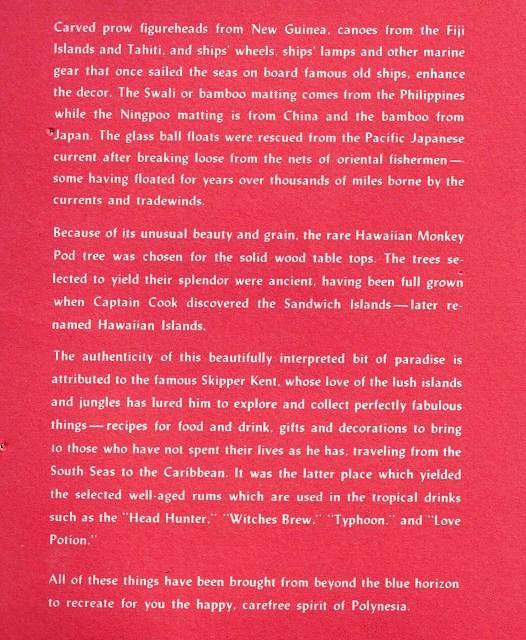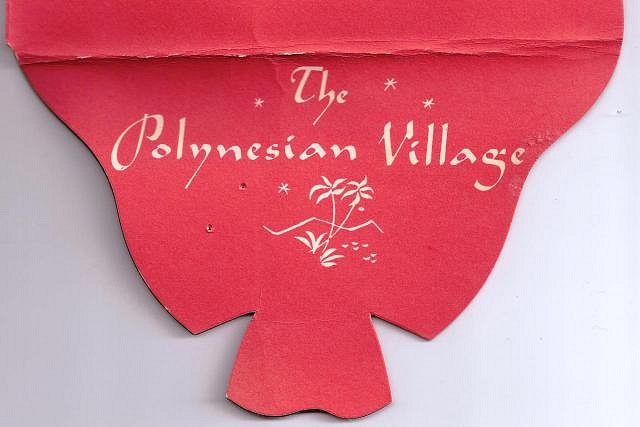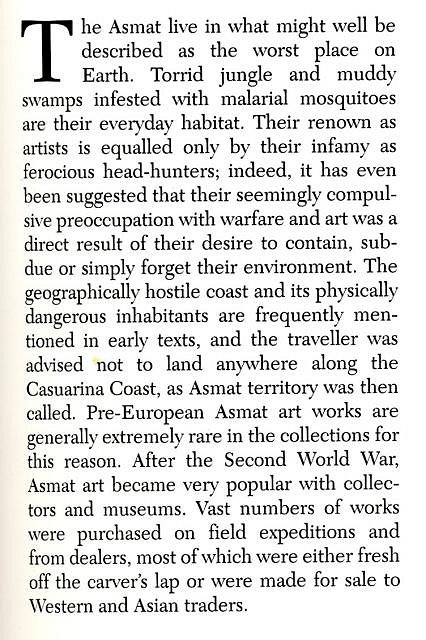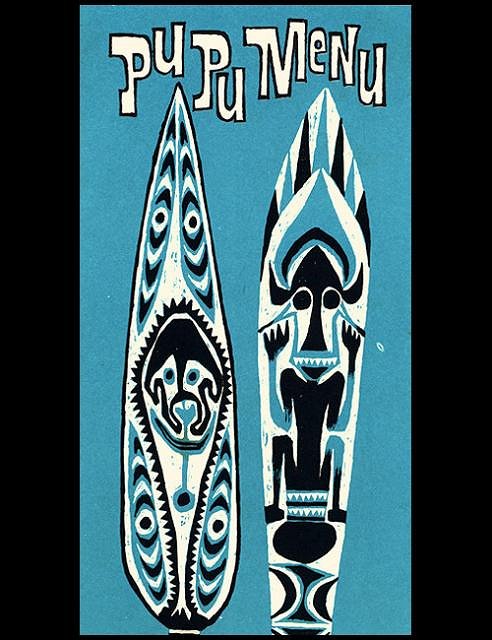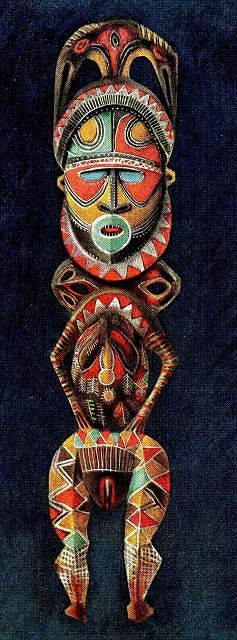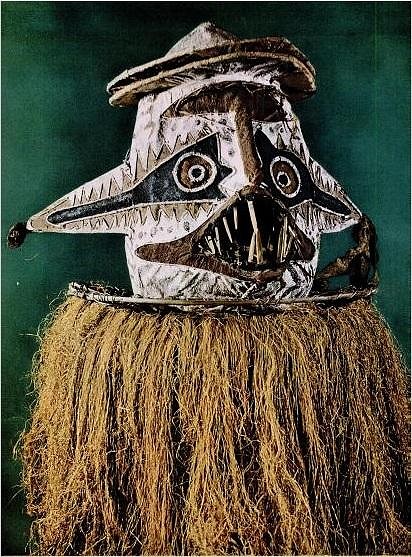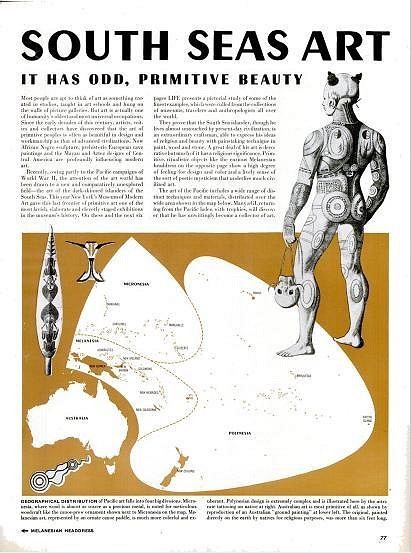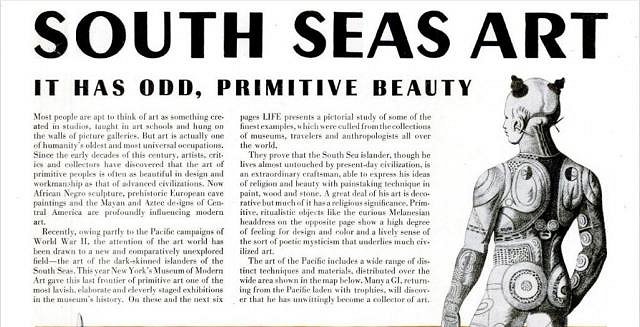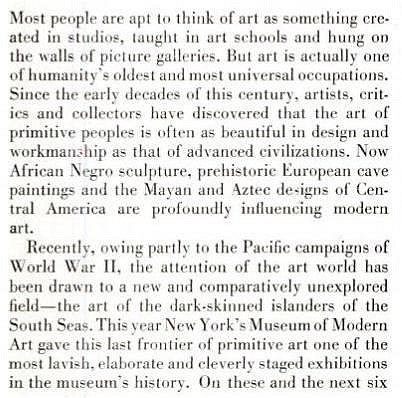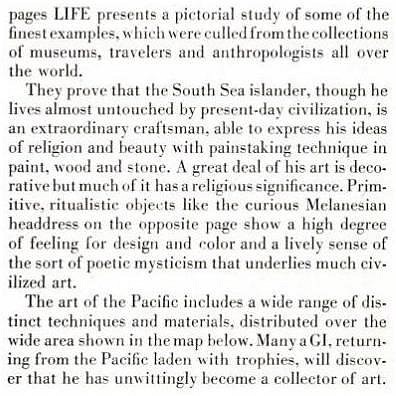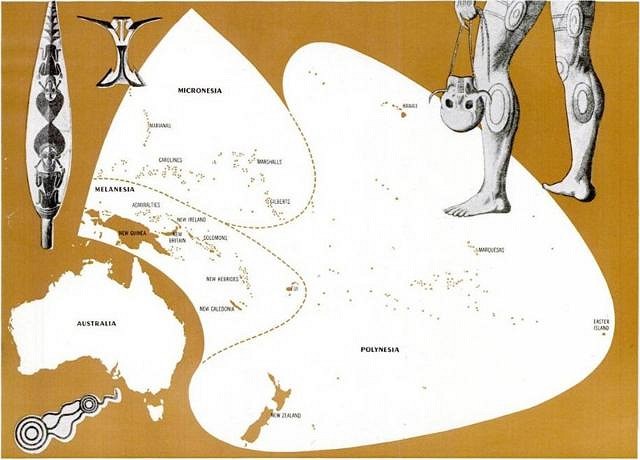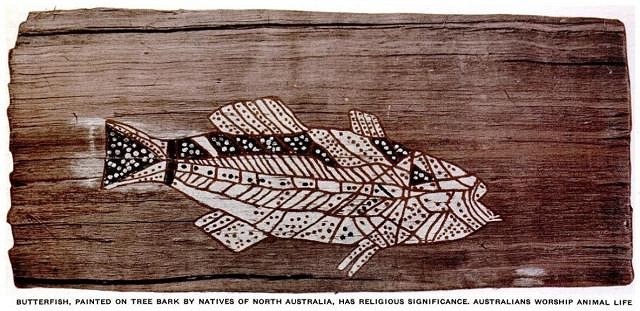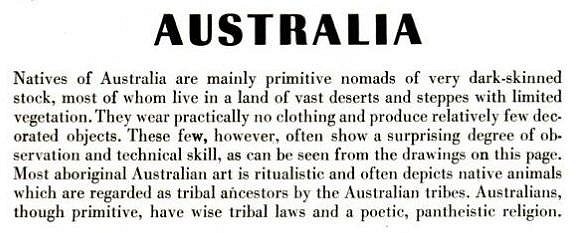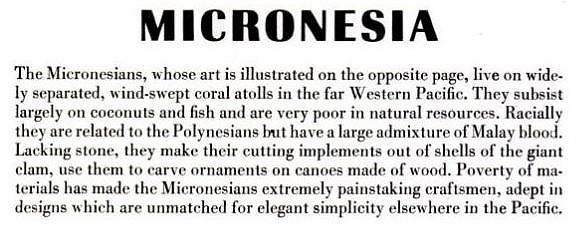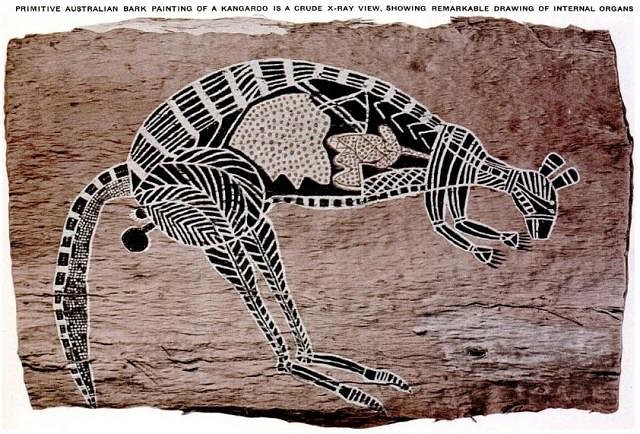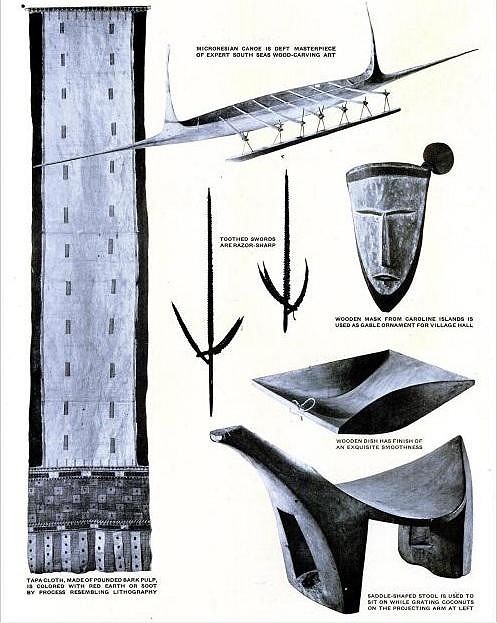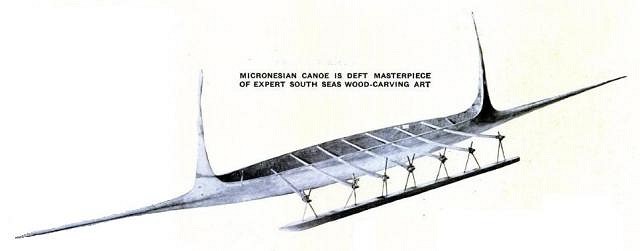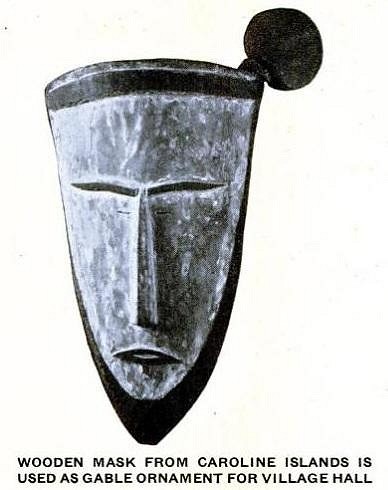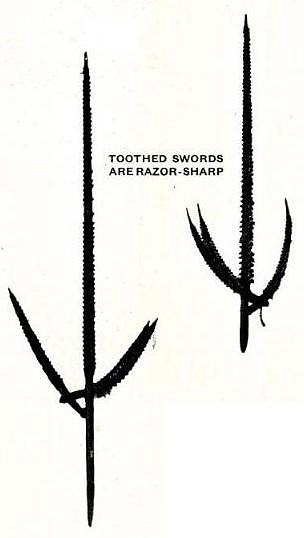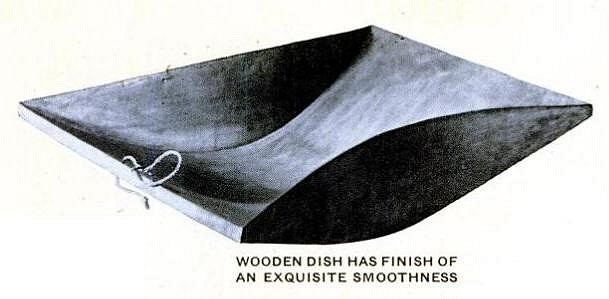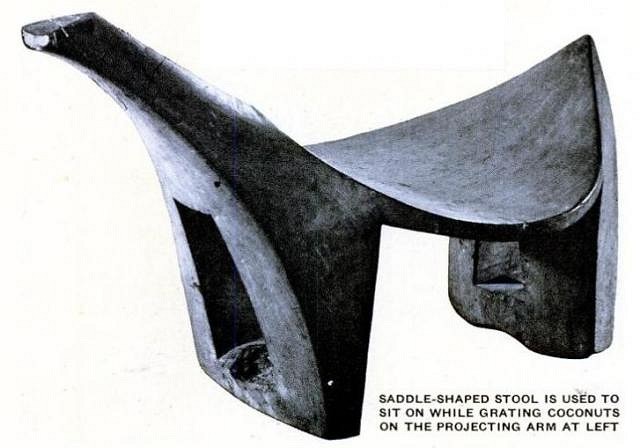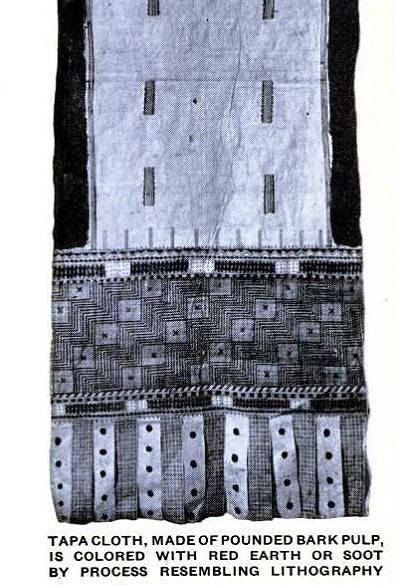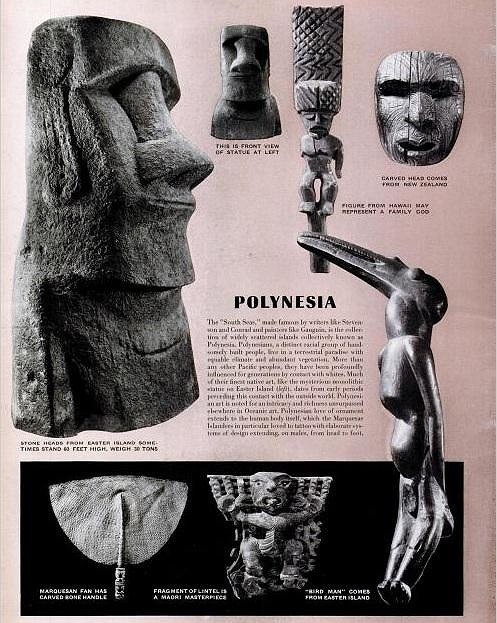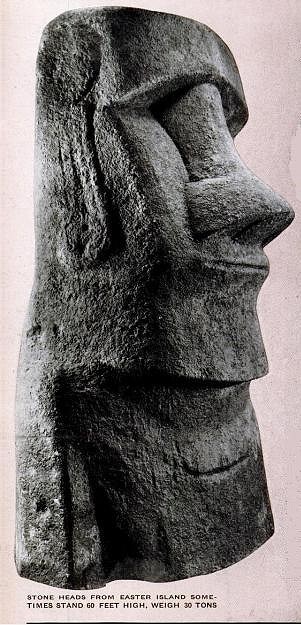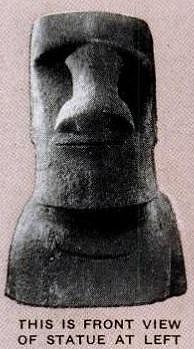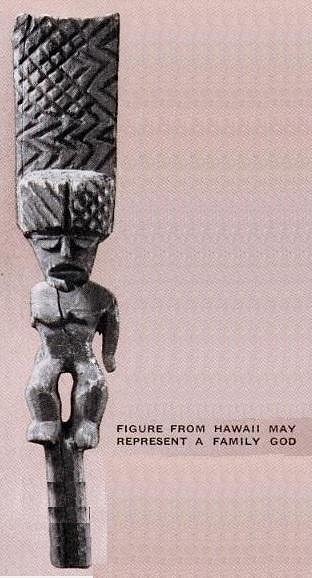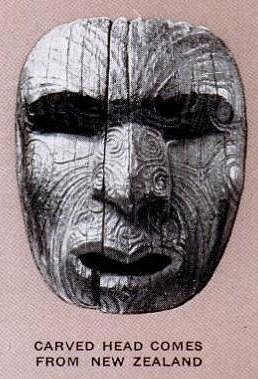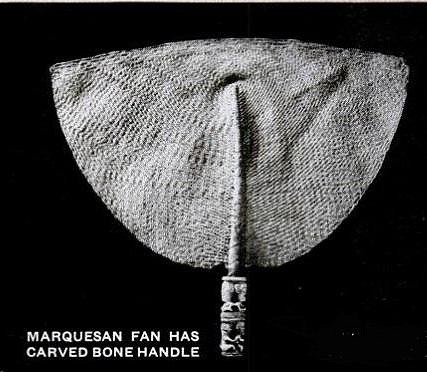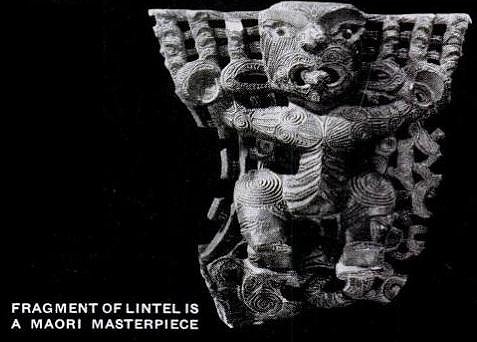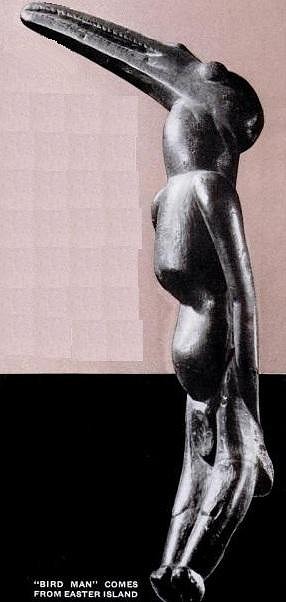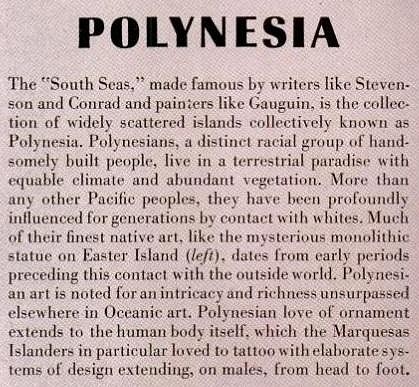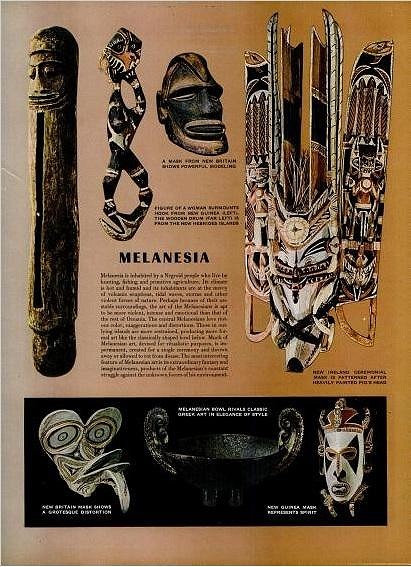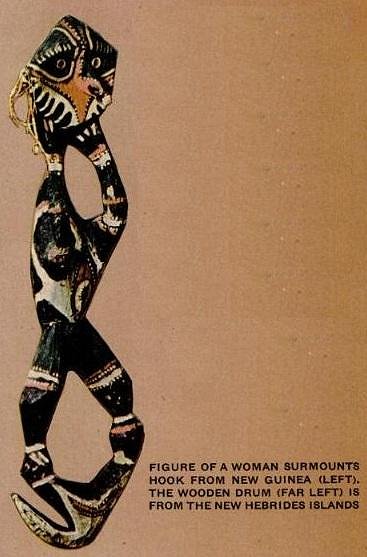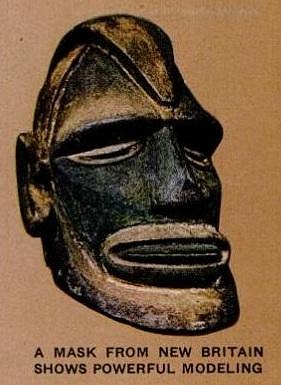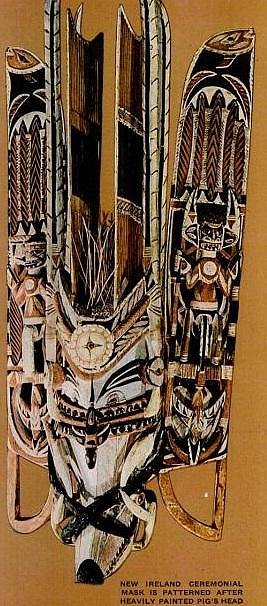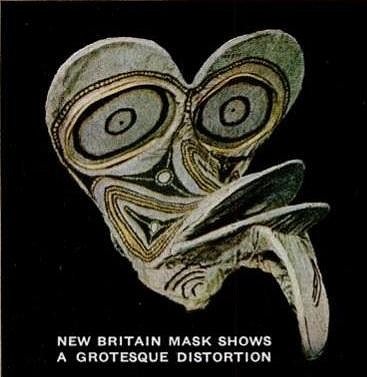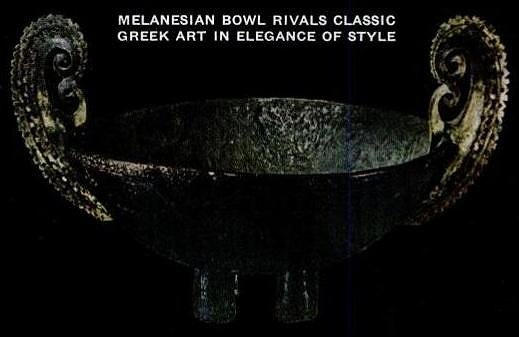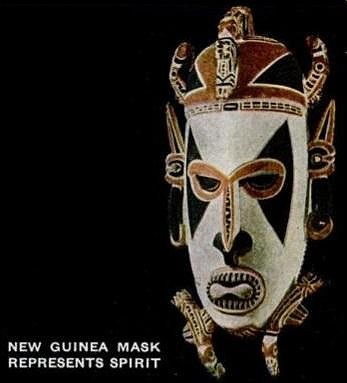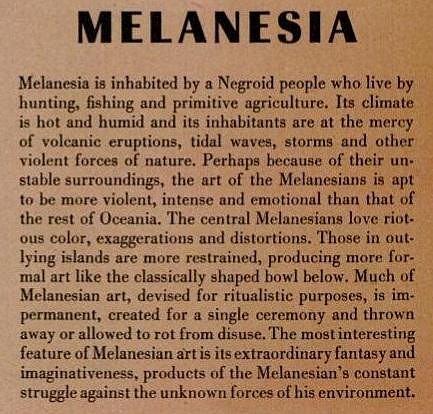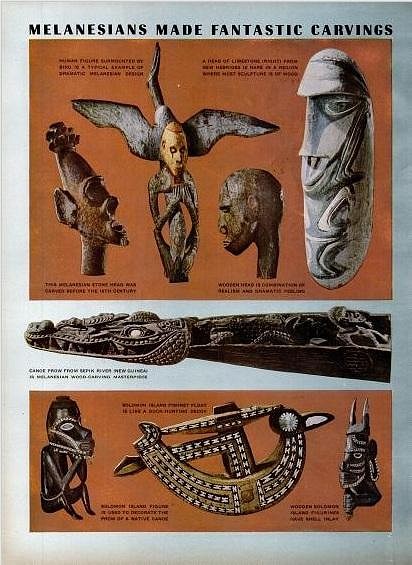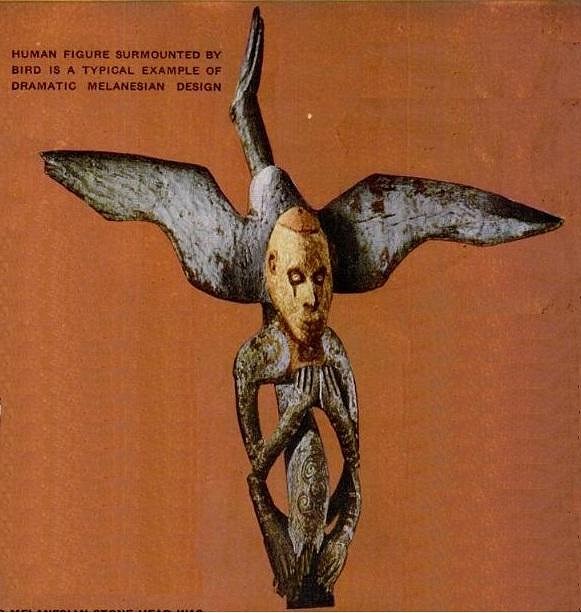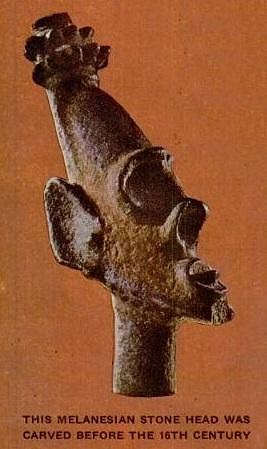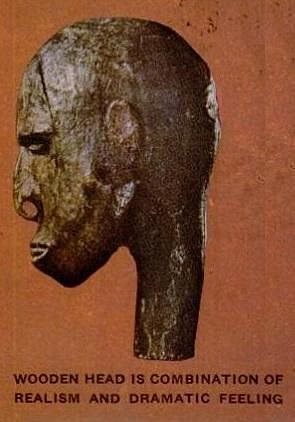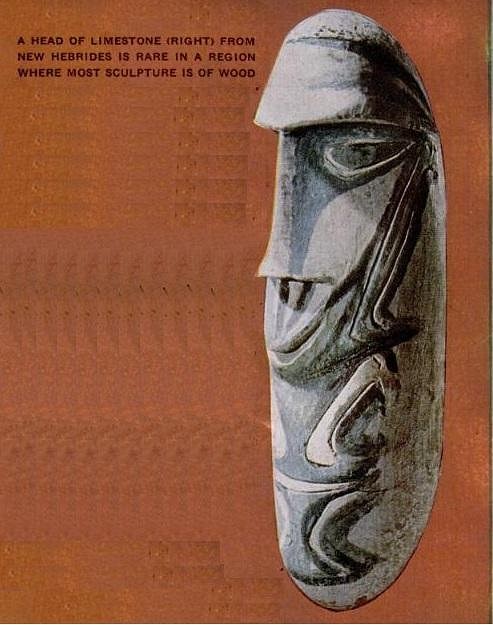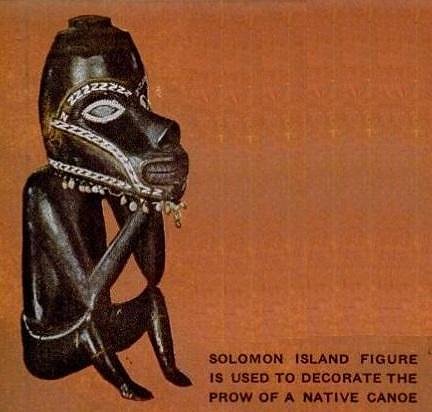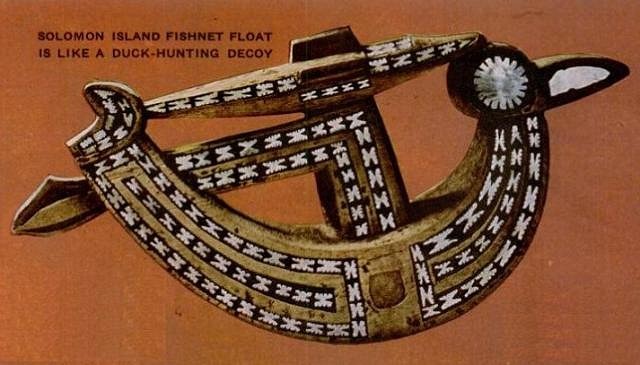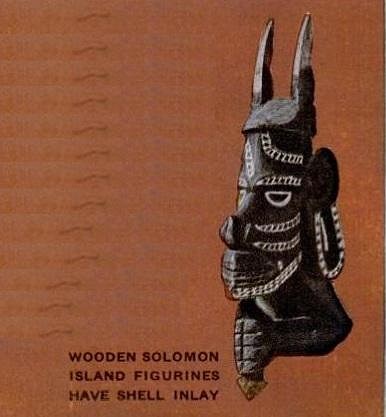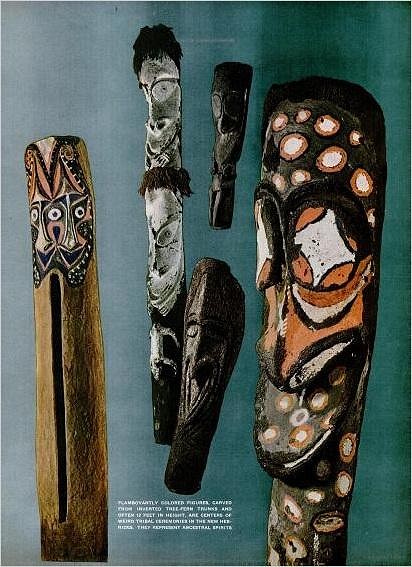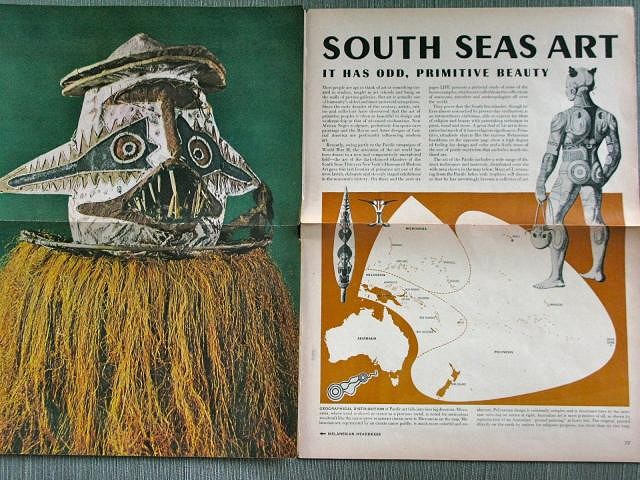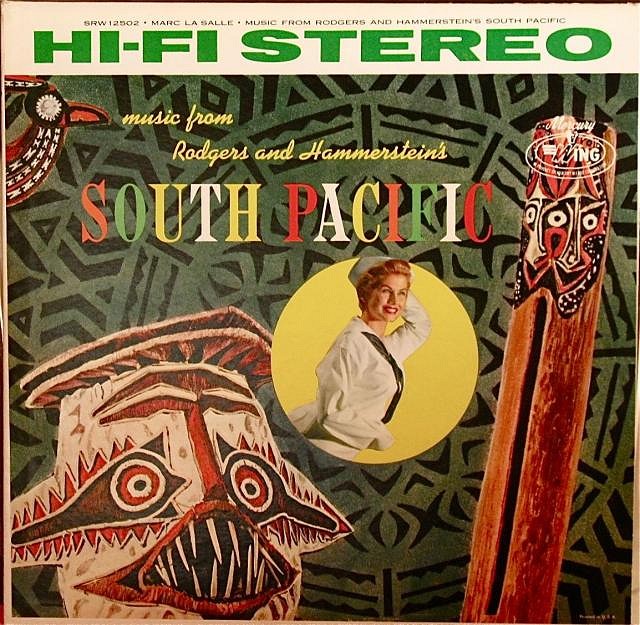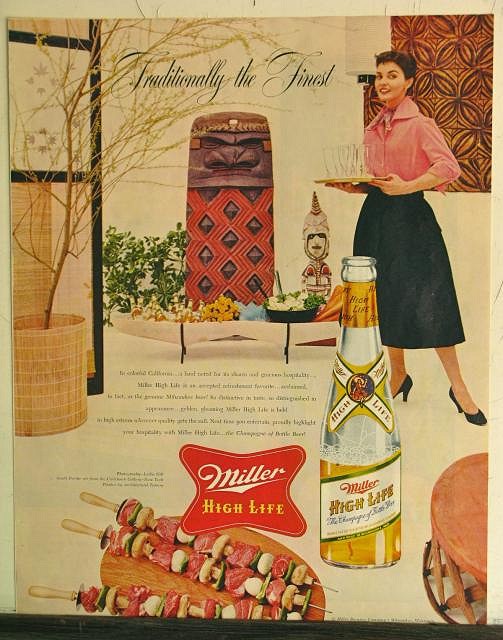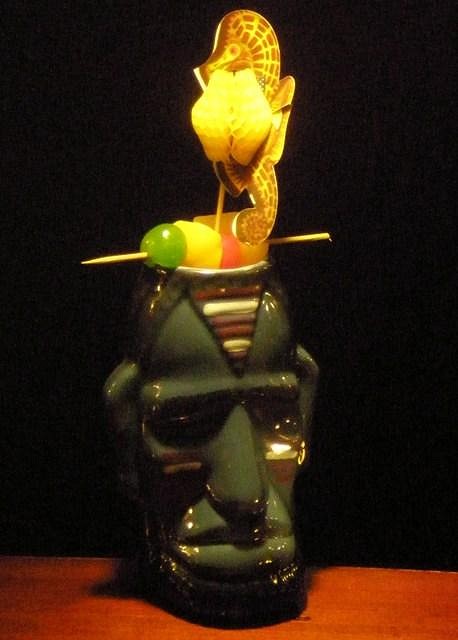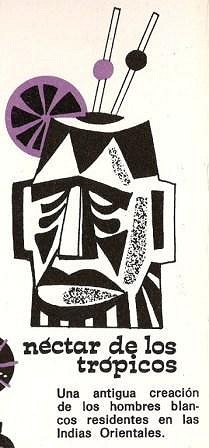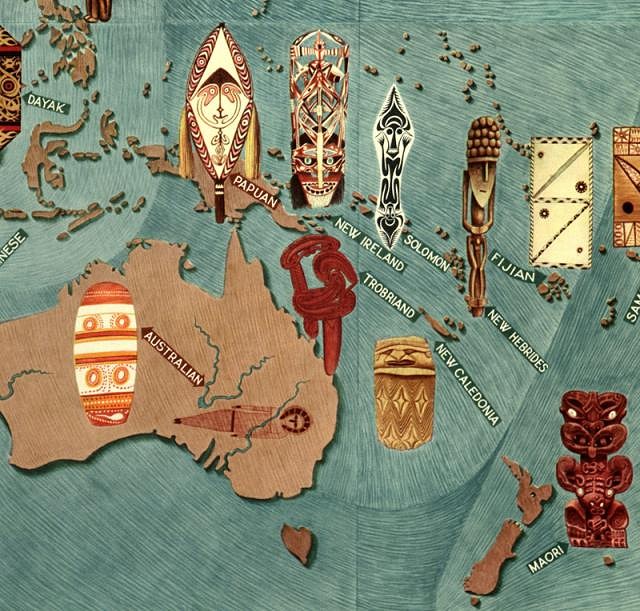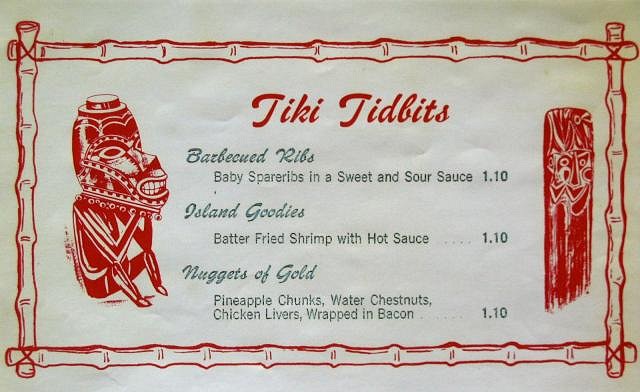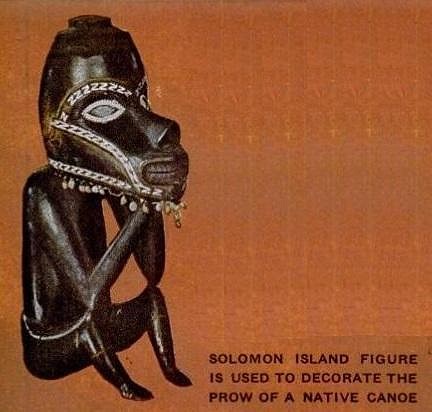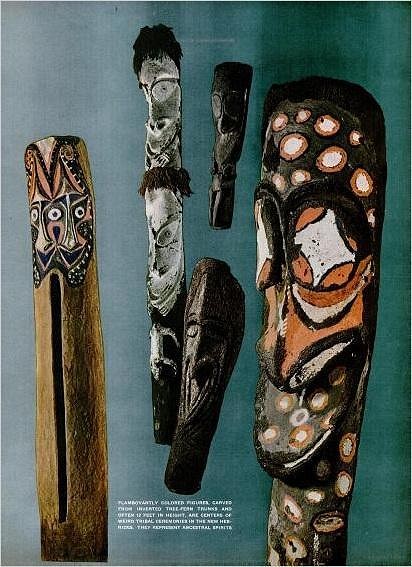Pages: 1 46 replies
|
B
bigbrotiki
Posted
posted
on
Tue, Feb 16, 2010 11:52 AM
Inspired by Babalu's recent posts on Papua New Guinea culture, I am posing this question: In America's urban bamboo hideaways of the 30s and 40s, the iconography of Hawaii, Tahiti, Samoa and other Polynesian islands was the dominant style. So when did MELANESIAN artifacts actually become a part of this world? It all seems to coincide with the heyday of Tiki, beginning in the late 50s. I am pegging Trader Vic as the main disseminator of Melanesian art into Poly pop. The T.V.'s logo mask (which all BOT readers know was based on a Covarrubias illustration from the 1946 Museum of Modern Art show)...
...became their icon sometime in the mid and late 50s. I do not recall it being used for their earliest franchises, the 1949 Seattle Outrigger, and the 1951 San Francisco Vic. I first found it in the 1955 Beverly Hilton menu (which also introduced the Maori logo Tiki on its cover): and the 1958 Savoy Hilton N.Y. menu: From then on it appeared on their matches...
...and their plates and many other items. In terms of decor, it was Barney West, who provided most of T.V.'s carvings, whose masks I noticed first at the Portland Trader Vic's, which opened in 1959:
It seems Melanesian decor coincided with the introduction of the A-frame, which of course was inspired by PNG/Palau architecture. Of course, Bob and Leroy were there too, literally, with their rite of passage trip to Papua New Guinea in 1960:
I also believe that the 1954 book "Oceanic Art", which was used by Bob & Leroy and so many Poly Pop artists of the time, played an important role and was a main reason PNG art infiltrated Tiki temples. So I call upon the gods of paper ephemera (that'll be you Sabu, DC, etc...): What other examples of PNG art can you find from the Tiki period in A.) Graphic design, and AND, I am especially curious: Do you have any examples of the use of PNG art in PRE-Tiki times? (30s- early 50s ?) Also, all the Mai Kai afficionados (Gator Rob, Swanky, Kiliki, etc..): What Barney West and other PNG examples can you share from there....and, here's the challenge, can you DATE their introduction? |
|
K
Kaiwaza
Posted
posted
on
Tue, Feb 16, 2010 12:08 PM
Not to be stupid, but, wouldn't have Melanesian art basically been part of "Poly pop" since the beginning? After all, Bali Hai is a Melanesian island..the inspiration anyway, and much WWII fighting was in Melanesia, so artifacts would have been brought home. I'm not even sure most American did (or do) even know the difference between Poly and Melanesia. |
|
B
bigbrotiki
Posted
posted
on
Tue, Feb 16, 2010 12:47 PM
For discussing this subject, it is helpful to review this chart from the Book of Tiki:
...plus the BOT's chapters 5 and 6, and the Trader Vic chapter, which shows how the menu covers changed from pre-Tiki Poly Pop to Tiki Poly pop. |
|
C
christiki295
Posted
posted
on
Tue, Feb 16, 2010 12:49 PM
My late dad was in PNG in WWII, which may anecdotaly corroborate that timeline. |
|
B
bigbrotiki
Posted
posted
on
Tue, Feb 16, 2010 12:53 PM
...which was discussed in that OTHER thread, below. :) Would be great if you can find any photos of him for it! http://www.tikicentral.com/viewtopic.php?topic=35520&forum=1&6
[ Edited by: bigbrotiki 2010-02-16 13:01 ] |
|
B
bigbrotiki
Posted
posted
on
Wed, Feb 17, 2010 12:17 AM
C'mon guys....nobody wants to play?
|
|
STCB

Sabu The Coconut Boy
Posted
posted
on
Wed, Feb 17, 2010 12:26 AM
I am assembling my images :) I need to photograph one in daylight that's too big to scan. |
|
G
GatorRob
Posted
posted
on
Wed, Feb 17, 2010 8:49 AM
Regarding the Mai-Kai, I haven't seen anything to indicate there was very much New Guinea art or New Guinea-inspired art prior to their major expansion in 1970. As you know, now there is the New Guinea dining room:
This drawing dates to the 1970 expansion when Tonga, Bangkok, Moorea and Tahiti were added (Tonga being space that was previously occupied by the Surf Bar). That expansion also enlarged the Molokai Bar and kitchen, and added the outdoor gardens and lagoon and the chinese ovens. But although the New Guinea room space existed prior to the expansion, it was reconfigured into basically what it is today. I do not know if it contained any PNG art prior to 1970. We've talked about the New Guinea-inspired winged carving that originally was located inside and is now (at least the lower half of it) in the outdoor gardens. That tiki dates back to the late 50s, possibly even the opening of the Mai-Kai in '56. It can be seen in this photo (can't remember who originally posted these):
and just barely in this one:
And then there is also this huge New Guinea-inspired carving that once stood outside fronting the road next to the sign (what a sight that must have been!):
This zoomed in partial photo comes from a post from definitedoll and she states it was taken in 1967. I don't know when that tiki first entered the scene. I've seen one other picture of it, but it's not dated. |
|
B
bigbrotiki
Posted
posted
on
Wed, Feb 17, 2010 11:32 AM
Great info, thank you Rob. Funny how small the Mai Kai seems compared to its "backstage". An how simple the Surf Bar was. It'll be hard to peg the changes in decor without eyewitnesses (the Thorntons, George Nakashima, etc), but it seems because of Barney West there was some early PNG stuff present. He definitely used that 1946 Arts of the South Seas book, after all the cover became his logo (see BOT). But most of it seems to have appeared AFTER the 50s. I wonder if Will Plugger has had any indication of when those molds were made. Maybe Oceanic Arts has dated records of items ordered. |
|
STCB

Sabu The Coconut Boy
Posted
posted
on
Wed, Feb 17, 2010 8:47 PM
I'm afraid my first post on the subject is just going to reinforce Bigbro's original proposition. Instead of showing Melanesian examples in Pre-Tiki Poly-pop, I'll offer a few reasons why they seem to be largely absent. Hopefully we can find some exceptions later. First, three examples of Pre-Tiki Poly-Pop: Don The Beachcomber's map of a South Seas Paradise leaves out New Guinea and Melanesia:
Trader Vic's first map (Oakland Era) is even simpler:
And the Matson Line Cruises of the 1930s did not go there:
New Zealand; Yes. Pago-Pago; Yes. Hawaii & Tahiti; Yes. In the picture above, notice the Lyre Bird of Australia, but no spectacular New Guinea Bird-of-Paradise. These are the islands tamed by the missionaries. Idyllic and peaceful with white sands, palm trees, and lovely maidens. New Guinea offered tribal warfare, mangrove swamps, head-hunters and leeches. It hadn't been tamed yet. Covarrubias shows Melanesia on his maps of the 40s:
But that's natural because he's presenting an ethnographic point-of-view and Melanesia is culturally fascinating. But South Sea bars and South Sea cruises were selling escapism and I think Melanesia might have been just a little too dark and too dangerous for them. Later, the tiki bars embraced their primal imagery but maybe in the 30s and 40s it wasn't readily available to a Trader and a Beachcomber traveling the world. In other words, maybe Trader Vic and Don the Beachcomber first used what was most handy - decor from the islands people actually traveled to (via Matson Lines and others). Later, looking for new sources, they eventually incorporated PNG decor from books and museum collections. Just a theory - feel free to poke holes in it.
[ Edited by: Sabu The Coconut Boy 2010-02-17 22:14 ] |
|
STCB

Sabu The Coconut Boy
Posted
posted
on
Thu, Feb 18, 2010 12:02 AM
Another indicator might be which restaurant was the first to use the New Guinea A-Frame.
:down: Trader Vic's Oakland - no A-frame:
:down: Trader Vic's San Francisco - no A-frame:
:down: Trader Vic's Chicago - First New Guinea-style A-frame:
:down: Trader Vic's New York - New Guinea to the hilt:
Even though the San Fran location on Cosmo Place didn't have an A-frame, it might have been the first to use the New Guinea logo. Here's a photo of Vic at Cosmo Place with the newly-carved logo:
And the San Francisco menu might have been the first to use PNG imagery:
[ Edited by: Sabu The Coconut Boy 2010-02-18 00:28 ] |
|
V

virani
Posted
posted
on
Thu, Feb 18, 2010 6:09 AM
I think in the first half century, tiki restaurants wanted to show what people would dream of, and well, I think they dreamed about polynesia because of the stories of the islands of Tahiti, Bora Bora, the wahines... |
|
D
Dustycajun
Posted
posted
on
Thu, Feb 18, 2010 10:31 AM
I am catching up on this one a little late, some how missed Bigbro's first request for info. Nice work as usual Sabu, I like the architectural tie in. Certainly seems as though the PNG architecture was incorporated before the art. Here are a couple other examples. This is a great shot of the exterior of a Butlin's Beachcomber that used the PNG architectural style and art on the exterior.
Also the Bali Hai at Pontchartrain Beach in New Orleans.
You can see a PNG style shield on the back wall of the Bali Hai next to the mural.
The Bali Hai dates from the 1960s. Will have to peruse my files to see if I can find some art work. DC |
|
D
Dustycajun
Posted
posted
on
Thu, Feb 18, 2010 11:36 PM
I think that the PNG art style may have been embraced more readily as a Tiki theme by other countries. This is a good example from Canada to go with the Beachcomber photo from England.
DC |
|
B

Babalu
Posted
posted
on
Fri, Feb 19, 2010 10:22 AM
Wow, keep up the great work you guys...this is some really interesting stuff. You got my "favorite thread" vote for the day :) |
|
B
bananabobs
Posted
posted
on
Fri, Feb 19, 2010 5:59 PM
Melanesia is a subregion of Oceania extending from the western end of the Pacific Ocean to the Arafura Sea, and eastward to Fiji. The region comprises most of the islands immediately north and northeast of Australia. The name Melanesia was first used by Jules Dumont d'Urville in 1832 to denote an ethnic and geographical grouping of islands distinct from Polynesia and Micronesia. I had to look it up and I figured someone else might want to know. [ Edited by: bananabobs 2010-02-22 19:40 ] |
|
D
Dustycajun
Posted
posted
on
Sun, Feb 21, 2010 9:38 AM
This is the only other example of the Covarrubias drawing I remember seeing for a Tiki-themed establishment.
DC |
|
D
Dustycajun
Posted
posted
on
Sun, Feb 21, 2010 2:49 PM
This matchbook is from Vagabond's House in Los Angeles and certainly predates Trader Vics.
Is that Melanesian art? DC |
|
STCB

Sabu The Coconut Boy
Posted
posted
on
Sun, Feb 21, 2010 2:58 PM
Sorry, DC. I checked that one too. The shield is Indonesian or Dayak. I think Vagabond's House and related places are the right places to look though. Any world explorers or Traders who opened bars might have a Melanesian piece. I think Skipper Kent had PNG items pretty early - maybe 1950s. That's a fantastic shield though. And so close. The trouble with Southeast Asian and Melanesian artifacts is that they can look so similar, but be created by different cultures. The Karo-Batak A-frame houses of Java can be nearly indistinguishable from the A-Frames of Papua New Guinea. To make matters even more confusing, the Asmat artifacts of West Irian (the western part of New Guinea) often get included in books of Indonesian and Southeast Asian art, when they are Melanesian instead of Asian.
[ Edited by: Sabu The Coconut Boy 2010-02-21 15:17 ] |
|
STCB

Sabu The Coconut Boy
Posted
posted
on
Sun, Feb 21, 2010 3:08 PM
In this postcard of Skipper Kent's you can see a New Guinea drum and canoe hanging from the ceiling:
Unfortunately in the older postcard below the items aren't there yet. I wonder when he added the PNG pieces.
|
|
B
bigbrotiki
Posted
posted
on
Mon, Feb 22, 2010 11:55 AM
Scott, here is the source: http://www.tikicentral.com/viewtopic.php?topic=28990&forum=1&vpost=394116 Check out the whole thread, it has a lot of Vagabond's House info, and my musings about the origin of Don the B.'s name. :) |
|
PTD
Psycho Tiki D
Posted
posted
on
Mon, Feb 22, 2010 5:10 PM
PTD |
|
D
Dustycajun
Posted
posted
on
Mon, Feb 22, 2010 5:58 PM
Sabu and Bigbro, Thanks for the info on the Vagabonds House shield. The Trader Vic's at the International Market Place in Hawaii also had a full size replica of the Covarrubias Tiki. Saw this image on a brochure on ebay.
DC |
|
B
bigbrotiki
Posted
posted
on
Mon, Feb 22, 2010 6:49 PM
Here's another interesting question: WHEN did that Spencecliff Trader Vic's move upstairs into the international Marketplace? Late 60s? That sign looks almost early 70s. And PTD, don't "DAVID" us by posting mute pictures :D ....WHEN and WHERE was the question. So far, the evidence points to the fact that Tiki temple designers did not avail themselves of New Guinea art until the 60s, Trader Vic being a trailblazer with his logo in the late 50s. |
|
PTD
Psycho Tiki D
Posted
posted
on
Tue, Feb 23, 2010 5:00 AM
Pictures are from this book...
I would only be assuming since this was published in 1943, that most of the pictures and the stories would have been from the late 1930's to early 1940's. Mentions of unexplored and unrefined territories, cannibalism and polygamy follow the time line. PTD |
|
B

Babalu
Posted
posted
on
Tue, Feb 23, 2010 8:13 AM
Taking a slightly different trail to perhaps help solve some of this question: The first real movie production that I can find to be shot in New Guinea seems to have happened in 1956. An Australian film titled "Walk Into Paradise"....Right around the same time frame it appears to have been also released in America under the title "Walk Into Hell". It looks like a fun movie...hope to see it sometime. Found some short clips here: http://aso.gov.au/titles/features/walk-paradise/clip2/
Curator’s notes The difference is that they chose to shoot it in the Australian-administered territories of Papua and New Guinea (before the country gained independence). This gives the film a pro-colonial romanticism, in which Rafferty can shoulder the white man’s burden – to bring civilization to the savage heart of New Guinea, a place few Australians had seen, but all had heard about, because of the war with the Japanese. The film saw itself in exactly these terms. New Guinea, says the introductory narration, is an island where 'today a gallant band of young Australian administrators are bringing civilization to the most primitive people left on the face of the earth’. The surprise of the film is not that some scenes are conceived with a casual racism, but that the film attempts to understand its environment. There’s a strong paternalism that was also true of the Australian administration, but also a perceptible degree of warmth and respect for cultural difference. Indeed the reason that the expedition runs into trouble is specifically because the doctor, played by French actress Françoise Christophe, chooses to ignore a taboo against the taking of blood. She does it after being warned, in order to save the lives of two children with malaria, but it makes clear that the warriors have their reasons for an attack. The film was shot on location in several inhospitable locations, and it has some remarkable footage to show for it: Sepik River long canoes paddled exclusively by women, and a full-scale highlands sing-sing, with hundreds of warriors in traditional dress trampling down grass to make an airstrip. Much of the story mirrors incidents in the pioneering expeditions of the Leahy brothers, the first white men to reach the New Guinea highlands, in the early 1930s. The film was also notable for being a co production with France. It was shot in both French and English versions simultaneously, the French dialogue scenes directed by Marcel Pagliero. Post-production was completed in France. The film was retitled Walk Into Hell and embellished with additional jungle footage for its US release, by veteran low-budget producer Joseph Levine. It was released in Paris as L’Odyssee du Capitaine Steve. |
|
B
bigbrotiki
Posted
posted
on
Tue, Feb 23, 2010 4:18 PM
What, not "Walk into Paradise"!? That film looks like a predecessor to the Mondo genre. Great poster. PTD and Baba, this thread is really more about the question of when specifically the ARTIFACTS began to appear in Poly pop BARS and RESTAURANTS, and in which ones. :) |
|
D
Dustycajun
Posted
posted
on
Tue, Feb 23, 2010 5:10 PM
OK, Here is a new one that specifically mentions New Guinea and Melanesia in the menu description and also uses the Covarrubias Tiki image. This is off the menu from the Polynesian Village Restaurant in the Edgewater Beach Hotel in Chicago. This place could date into the early 1950s.
Sabu, Bosko and I have been posting about the connection of this place with Skipper Kent here: http://www.tikicentral.com/viewtopic.php?topic=34213&forum=2&8 DC |
|
B
bigbrotiki
Posted
posted
on
Tue, Feb 23, 2010 5:29 PM
Thank you for the better scan, very cool summation of Polynesian (or "South Seas") pop in general!
"Could" is not good enough, I demand hard evidence! :) |
|
J
JOHN-O
Posted
posted
on
Tue, Feb 23, 2010 5:34 PM
Wait, I'm confused. Wouldn't the appearance of Melanesian (physical) art coincide when Oceanic Arts started producing the stuff? I can see where the early Polynesian pieces might have been authentic art from Hawaii but a place like PNG was rarely traveled (as it still is today). Surely the first Melanesian objects appearing in U.S. restaurants and bars couldn't have been authentic. Also I'm guessing all of the shield/spear iconography appearing on motel signs, etc. was inspired by the first American carver(s) to copy the look from Oceanic Art books. Back then, what motel developers even knew of the culture they were borrowing from? They wouldn't have cared whether it was Polynesian, Melanesian, or African, as long as it vibed "exotic". [ Edited by: JOHN-O 2010-02-23 17:36 ] |
|
B
bigbrotiki
Posted
posted
on
Tue, Feb 23, 2010 6:06 PM
|
|
B
bigbrotiki
Posted
posted
on
Tue, Feb 23, 2010 6:13 PM
And I am not only going by the decor, but also by the graphics. Here is a great menu cover from Mimi's site, the 1966 Pu Pu menu from the Mai Kai:
|
|
D
Dustycajun
Posted
posted
on
Wed, Feb 24, 2010 7:40 AM
Bifcozz's great post with the Skipper Kent letters shows that the Polynesian Village restaurant opened on New Years eve of 1954, I am pegging that menu from the early days given the look and the prices and the "55" trademark stamp noted by Bosko. DC |
|
CT
Const Tiki
Posted
posted
on
Sun, Mar 14, 2010 11:30 PM
What does the Trader Vic's/Covarrubias Tiki represent anyway? |
|
B
bigbrotiki
Posted
posted
on
Mon, Mar 15, 2010 12:35 AM
The funny thing is that it is a FEMALE Abelam figure, easily proven if you look between its legs:
...a detail which curiously has been omitted on this menu, so they must have noticed :D :
I don't think "Arts of the South Seas" has any more specific information about it, I am away from my archive so I can't check. |
|
A
aquarj
Posted
posted
on
Mon, Mar 15, 2010 2:07 PM
With apologies for getting specific, are you sure that's what you think it is? It's a little hard to tell in a 2D rendering. Instead of an "inny" couldn't that be an "outy" body part (albeit a little small as a carved representation)? Not that I'd know - maybe there are other elements supporting that conclusion. Or maybe the book illustration says it's a female, I didn't check. But just visually, I always thought that face structure kind of looked like a bearded and tattooed male. -Randy |
|
CT
Const Tiki
Posted
posted
on
Mon, Mar 15, 2010 5:43 PM
Sven, it would be appreciated if you could provide some more info about this tiki when it's convenient. I've always liked the image and would like to learn a little more about it. Constantine |
|
B
bigbrotiki
Posted
posted
on
Mon, Mar 15, 2010 11:21 PM
The caption sure does state "female". And I always felt the same about the impression the face makes: A very macho image for a macho Trader Vic. That's why it's so funny. Maybe he felt it reminded him of his step mom :D I will not get back home until a month from now, so someone else who owns the book has to check it for more info. I doubt there is, the plates in it were more often used a loose illustrations of the general ethnographic text. Then again, this one has a full page, and is only one of five (or so) color ones done by Covarrubias. It would be interesting to find out where the piece is now, if it was owned by the N.Y Museum of Modern Art and they still have it, like the De Young Museum owning the OTHER Trader Vic Logo Tiki. But often, very little is known about the specific purpose of these carvings other than provenance of which region or village it came from. |
|
J
JONPAUL
Posted
posted
on
Tue, Mar 16, 2010 1:00 PM
The exact caption on page 106 of the first edition is as follows: Opposite: Large female figure made by the Abelam |
|
B
bigbrotiki
Posted
posted
on
Tue, Mar 16, 2010 1:06 PM
Thanks for looking it up, JP. Dang, I always mix up the N.Y. Natural History and Mod. Art museums. 58 inches, that's pretty big. Wonder if it has been sitting in storage for decades, in some underground "Raiders of the Lost Ark" warehouse. |
|
T

TikiTomD
Posted
posted
on
Tue, Feb 21, 2012 8:33 AM
Here's a visually intriguing Life Magazine article from November 4, 1946 that overviews Oceanic art, especially that from Melanesia, based on a New York Museum of Modern Art exhibit of that year...
-Tom |
|
B
bigbrotiki
Posted
posted
on
Tue, Feb 21, 2012 9:43 AM
Great post, Tom, you pegged an important step in the history of Oceanic Art becoming accepted in America. While the EXHIBIT itself was groundbreaking, and the BOOK from it became one of the two bibles of American Tiki artists, it was indubitably this lengthy full color LIFE article which brought the rich imagery of "South Seas Art" into American living rooms for the first time.
It took another 10 years to for the actual OBJECTS to a appear in home decor, but this show - and that article about it - was the beginning.
|
|
M
MadDogMike
Posted
posted
on
Tue, Feb 21, 2012 10:29 AM
Tom, thanks for bumping this thread. I'll leave to the scholars to answer "when", I'll only say that I'm glad that Melanesian art was included - such a rich region for inspiration. |
|
LT
LOL Tiki
Posted
posted
on
Tue, Feb 21, 2012 10:54 AM
Thanks for posting this stuff - I can look at images like this this all day! I'd wager that this was the inspiration for the Langerman's Luau mug
|
|
Z
Zeta
Posted
posted
on
Tue, Feb 21, 2012 12:55 PM
Mahalo for sharing TomD! I found this guy's Spanish cousin:
|
|
T

TikiTomD
Posted
posted
on
Wed, Feb 22, 2012 6:14 PM
This thread wouldn't be complete without a map view of Melanesia excerpted from Miguel Covarrubias' "Art Forms of the Pacific Area"...
In various TC threads, bigbrotiki and others have alluded to the great mystery surrounding the now missing original work of art, done as one of six murals for the 1939 San Francisco Golden Gate International Exposition (World's Fair) on Treasure Island. There's a January 16, 2008 online SF Weekly News article that summarizes what is known. See inside the front and back covers of the Book of Tiki for the complete map. -Tom |
|
B
bigbrotiki
Posted
posted
on
Thu, Feb 23, 2012 3:13 PM
Tom, "But a bigger indignity occurred in 2001, after the work of renovating the Ferry Building had already begun, with the murals — uncovered and unprotected — still on the walls. I had seen them there in situ in the mid-90s, and marveled at the office workers scurrying by without paying tribute. Here is another example of that LIFE article about the South Seas Art Exhibition finding its way into Polynesian pop, from the Aku Tiki Room menu:
|
Pages: 1 46 replies

